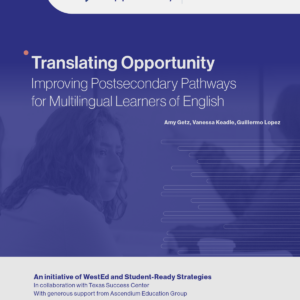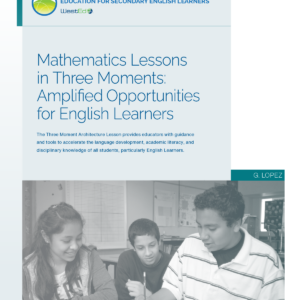Four Policy Levers May Increase English Learner Students’ Participation in Required Academic Courses
Posted on

State, district, and school leaders can improve outcomes for students who are classified as English learners through the use of specific levers that can increase these students’ access to academic instruction and content.
When students enter public school, their parents or caregivers fill out a questionnaire that asks about home language practices. An answer indicating that the student is exposed to a language other than English typically triggers an English proficiency test. How children perform on that test could very well determine the trajectory of their lives, reports the University of Oregon’s Around the O publication in an interview with Dr. Ilana Umansky, an associate professor with the university and researcher with the IES-funded National Research & Development Center to Improve Education for Secondary English Learners.
That is because in many states today, Umansky says, classification as an English learner changes the kinds of services and resources students receive in school. While some resulting effects of English learner classification may be beneficial for students learning English, others have been shown to be harmful. For example, many middle and high school students classified as English learners experience exclusionary tracking wherein they are excluded from full enrollment in core academic content courses. Being required to enroll in one or more English language development classes, for example, limits the time available to enroll in other classes, such as English language arts or math. Furthermore, English learner–classified students may also be barred from enrolling in specific classes until they reach a specified level of English proficiency.
In addition to limiting students’ opportunities to learn requisite content, exclusionary tracking creates barriers to graduation. Students experiencing exclusionary tracking may be unable to acquire the core content credits required for graduation.
Umansky and co-principal investigator Dr. Karen Thompson, Associate Professor at Oregon State University, along with their colleagues, have generated new data that supports the need for school, district, and state leaders to implement four specific solutions, or levers, to ensure that students classified as English learners can access core academic content classes such as math, science, social studies, and English language arts.
- Increase English learner–classified students’ access to extra instructional time, such as summer programs or additional periods in the school day. Umansky and Thompson’s team find that English learner–classified students who are given extra instructional time in middle and high school are far more likely to enroll in critical classes required for graduation, as reported recently in “How can middle and high schools improve support for English learners?” in K–12 Dive.
- Offer bilingual programs. The team’s new analysis of student data in Oregon revealed that if English learner-classified students participated in bilingual education programs in elementary school, such as dual immersion programs, they were more likely to be enrolled in core content area classes in middle and high school. Such bilingual programs in Oregon may have helped students build content knowledge in elementary grades, researchers hypothesize, thus better preparing them for content courses in middle and high school.
- Promote content teachers’ acquisition of state licensure for educating multilingual students. New National Research & Development Center to Improve Education for Secondary English Learners analysis shows that English learner-classified students are more likely to be enrolled in academic content classes when their prior-year teachers earned state licenses, such as an English for Speakers of Other Languages (ESOL) endorsement, a Bilingual specialization, or a Dual Language specialization.
- Ensure English learner–classified students’ access to school counselors. Researchers found that middle and high schools offering students access to guidance counselors had higher proportions of English learner–classified students enrolled in core content classes, including math, science, English language arts, and social studies.
Over the next 2 years, the Center will continue to explore these and other malleable levers that can expand course access for English Learner–classified students, looking more broadly at data from other states.
Since 2020, the National Research & Development Center to Improve Education for Secondary English Learners has sought to significantly advance the capacity of educators, policymakers, and researchers to serve students who are classified in school as English learners by bridging research and practice bidirectionally. Funded by a grant from the Institute of Education Sciences, the Center consists of a world-class research team from WestEd; the University of Oregon; Oregon State University; and the National Center for Research on Evaluation, Standards, and Student Testing (CRESST) at the University of California, Los Angeles. The Center seeks to (a) identify and describe the systemic barriers that prevent secondary English learner students from successfully accessing the general curriculum and (b) develop and test innovative, educative curriculum materials that enable these students to reach their full potential in community, college, and career.


